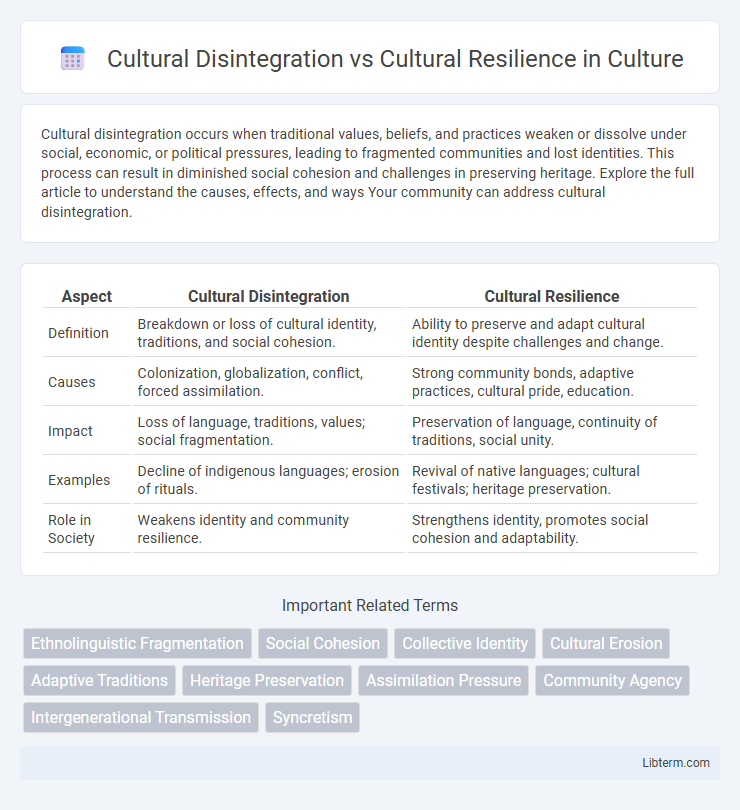Cultural disintegration occurs when traditional values, beliefs, and practices weaken or dissolve under social, economic, or political pressures, leading to fragmented communities and lost identities. This process can result in diminished social cohesion and challenges in preserving heritage. Explore the full article to understand the causes, effects, and ways Your community can address cultural disintegration.
Table of Comparison
| Aspect | Cultural Disintegration | Cultural Resilience |
|---|---|---|
| Definition | Breakdown or loss of cultural identity, traditions, and social cohesion. | Ability to preserve and adapt cultural identity despite challenges and change. |
| Causes | Colonization, globalization, conflict, forced assimilation. | Strong community bonds, adaptive practices, cultural pride, education. |
| Impact | Loss of language, traditions, values; social fragmentation. | Preservation of language, continuity of traditions, social unity. |
| Examples | Decline of indigenous languages; erosion of rituals. | Revival of native languages; cultural festivals; heritage preservation. |
| Role in Society | Weakens identity and community resilience. | Strengthens identity, promotes social cohesion and adaptability. |
Introduction: Defining Cultural Disintegration and Resilience
Cultural disintegration refers to the breakdown or erosion of traditional customs, values, and social structures within a community, often caused by external pressures such as globalization, colonization, or conflict. Cultural resilience, on the other hand, embodies a community's ability to preserve and adapt its cultural identity, practices, and knowledge in the face of such disruptive forces. Understanding these concepts is crucial for analyzing how societies maintain cohesion and continuity amidst change.
Historical Context: Roots of Cultural Change
Historical events such as colonization, forced migration, and globalization have significantly contributed to cultural disintegration by disrupting indigenous traditions and social structures. Conversely, cultural resilience emerges as communities adapt and preserve core identities through oral histories, rituals, and language revitalization efforts. The interplay between these forces shapes how societies respond to external pressures, influencing the survival or transformation of cultural heritage.
Drivers of Cultural Disintegration
Economic instability, rapid urbanization, and globalization act as primary drivers of cultural disintegration by disrupting traditional social structures and weakening community bonds. The influx of external cultural influences often leads to the erosion of indigenous languages, customs, and belief systems, accelerating the loss of cultural identity. Political marginalization and ineffective cultural policies further exacerbate the fragmentation of cultural heritage, undermining efforts to sustain cultural continuity.
Manifestations of Disintegration in Modern Societies
Cultural disintegration in modern societies manifests through the erosion of shared values, fragmentation of social norms, and weakening of traditional institutions. This often leads to increased social conflicts, identity crises, and diminished community cohesion. Such disruptions challenge the collective cultural identity and hinder social stability, prompting urgent need for strategies that foster cultural resilience and reintegration.
Understanding Cultural Resilience
Cultural resilience refers to a community's capacity to preserve and adapt its cultural identity, practices, and values amid external pressures and changes. It involves the dynamic process of sustaining traditions while integrating new influences, thereby strengthening social cohesion and continuity. Understanding cultural resilience highlights how societies resist cultural disintegration by fostering shared knowledge, collective memory, and adaptive strategies.
Mechanisms of Resilience: How Cultures Adapt
Cultural resilience is driven by adaptive mechanisms such as the preservation of core values, the integration of new influences, and community-driven innovation to maintain identity amid change. These mechanisms enable cultures to reinterpret traditions and practices in ways that address contemporary challenges while fostering social cohesion. In contrast, cultural disintegration often results from the breakdown of these adaptive processes, leading to identity loss and fragmentation.
Case Studies: Successes and Failures in Cultural Preservation
Case studies in cultural preservation reveal varied outcomes between cultural disintegration and resilience, highlighting the critical role of community involvement and adaptive strategies. Successful examples include the Maori of New Zealand, who revitalized their language through education reforms and media presence, countering disintegration despite historical suppression. Conversely, the extinction of the Beothuk people in Newfoundland illustrates failure stemming from colonial violence and lack of support for cultural survival mechanisms.
The Role of Globalization in Cultural Transformation
Globalization accelerates cultural transformation by introducing diverse values, technologies, and practices that challenge traditional identities, often leading to cultural disintegration as local customs are diluted or replaced. However, it also fosters cultural resilience by enabling communities to adapt, hybridize, and selectively integrate global influences while preserving core cultural elements. The dual impact of globalization shapes dynamic cultural landscapes where dissolution and revitalization coexist, emphasizing the importance of adaptive strategies in sustaining cultural heritage.
Strategies for Fostering Cultural Resilience
Cultural resilience thrives through strategies such as community empowerment, preservation of traditional knowledge, and adaptation to social changes, ensuring the continuity of cultural identity despite external pressures. Strengthening intergenerational dialogue and promoting inclusive cultural policies also bolster communities against cultural disintegration by reinforcing a collective sense of heritage and belonging. Sustainable cultural resilience integrates education, participatory governance, and digital preservation to maintain cultural diversity in an increasingly globalized world.
Future Outlook: Balancing Change and Continuity
Cultural disintegration poses challenges to preserving identity amid rapid globalization and technological advances, while cultural resilience ensures adaptation through maintaining core traditions and values. Future outlook focuses on balancing the dynamics of change, such as urbanization and digital influence, with continuity by fostering community engagement and intergenerational transmission of cultural knowledge. Sustainable cultural policies and inclusive education systems play a pivotal role in harmonizing transformation with heritage preservation for long-term social cohesion.
Cultural Disintegration Infographic

 libterm.com
libterm.com